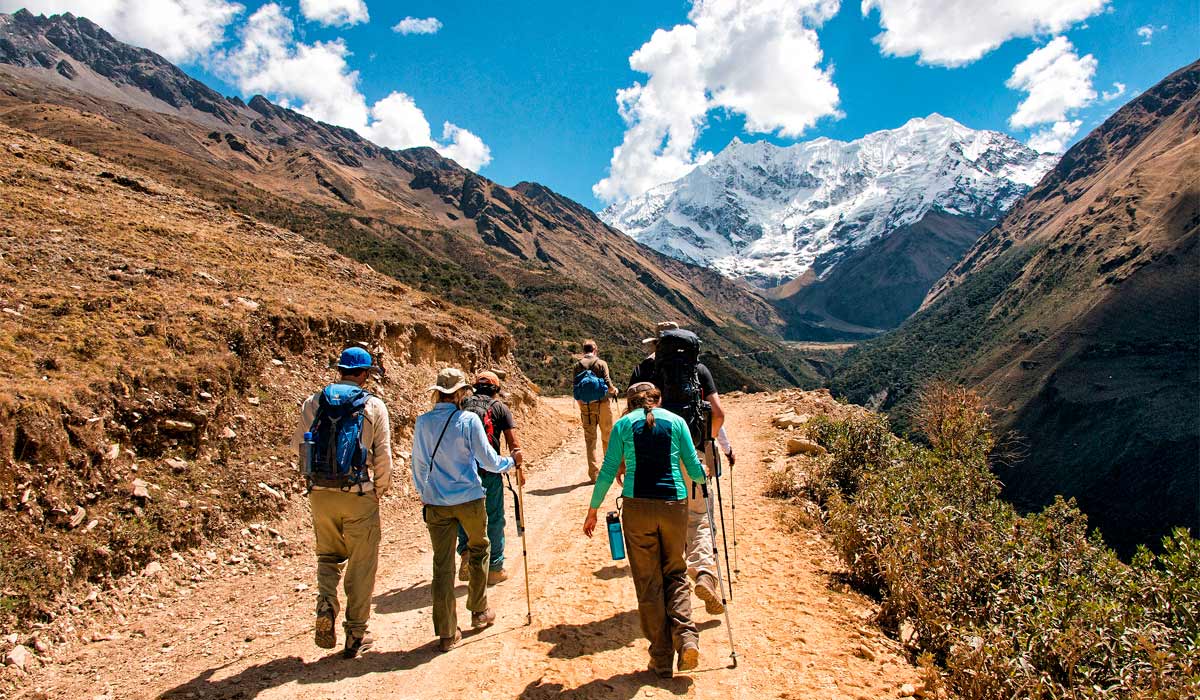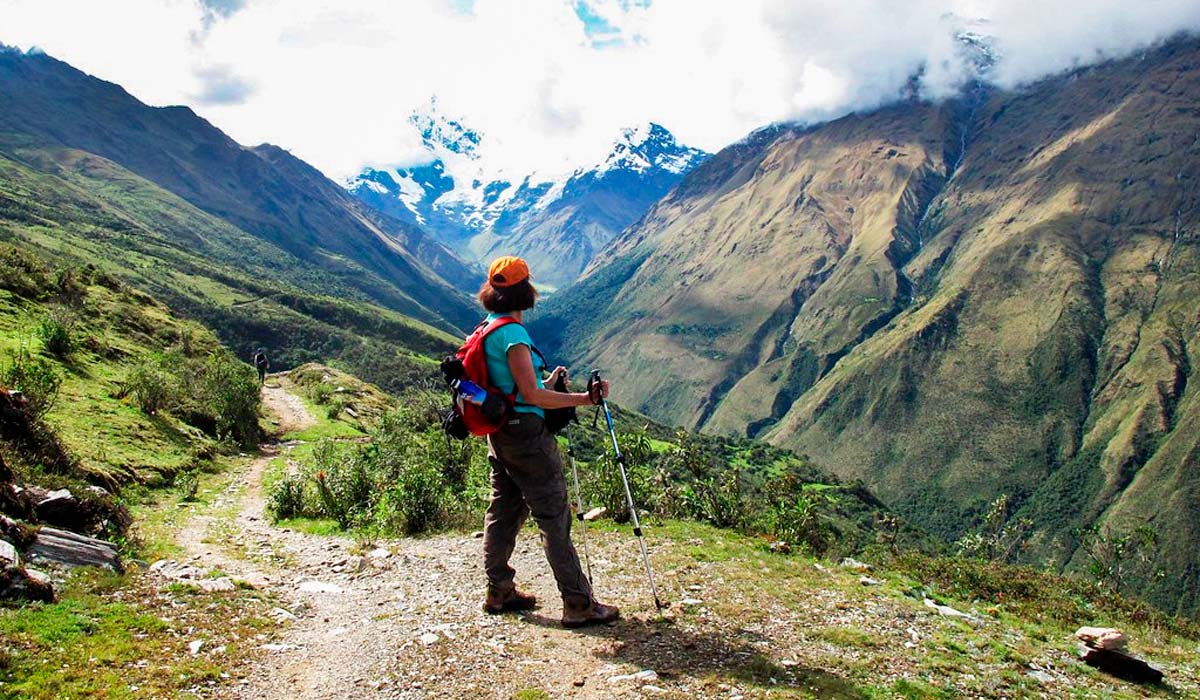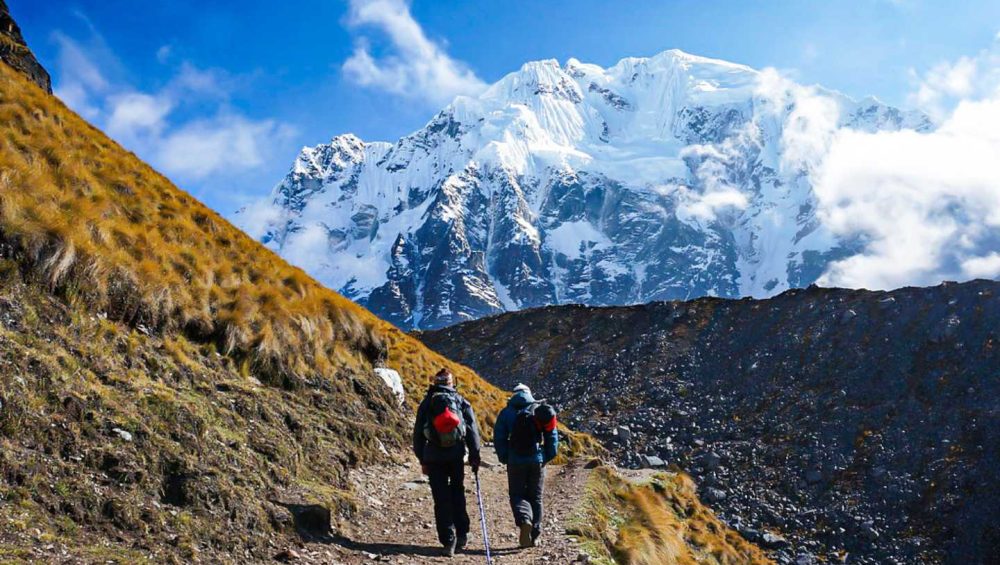The Salkantay Trek to Machu Picchu is one of the most exciting and authentic routes to reach Machu Picchu. This journey offers a unique combination of breathtaking landscapes, physical challenges, and a deep connection with Andean culture. Over several days, you will cross majestic snow-capped mountains, lush cloud forests, and incredible natural settings, all while getting closer step by step to the mythical Inca citadel.
If you are looking for a different alternative to the traditional Inca Trail, the Salkantay is an ideal option for adventure lovers. In this guide, we tell you everything you need to know to fully enjoy the journey: what to pack, what to expect on the way, and the unmissable moments that will make this journey an unforgettable experience. Get ready to discover one of the most impressive routes in Peru!
What is Salkantay?
The Salkantay is a mountain located in the Cusco region, Peru, with an altitude of approximately 6,271 meters above sea level. It is the second highest peak in the area and one of the most prominent in the Andean mountain range, famous for its imposing silhouette and for representing a true challenge for those who dare to explore it.
Beyond its spectacular natural environment, the Salkantay is part of one of the most recognized hiking routes that leads to the citadel of Machu Picchu. This journey offers adventurers an enriching experience, crossing diverse ecosystems and astonishing scenery at every step.
Meaning of Salkantay
The term “Salkantay” comes from the Quechua language and can be interpreted as “untamed mountain” or “wild mountain.” The word “Sallqa” refers to the wild or untamed, while “Antay” has multiple interpretations: some sources relate it to the Andes, and others to the idea of “producing avalanches.”
History of the Salkantay Snow-capped Mountain
Since ancient times, the Nevado Salkantay has been an object of great veneration by Andean cultures, especially by the Incas, who recognized it as an “Apu,” that is, a sacred mountain with spiritual power that protected nearby communities and marked the course of their lives. This veneration continues today, manifested in traditional ceremonies where the inhabitants offer prayers for abundant harvests, family well-being, and protection against adversity.
Beyond spirituality, the Salkantay has also been a key point within the network of ancient Andean roads. Although it is not included in the original layout of the Inca Trail, the Salkantay route has positioned itself as a prominent alternative due to its impactful landscapes and cultural value. Its snow-capped summit and the mystical environment that surrounds it make Salkantay an emblem of Peru’s natural and ancestral heritage.
Where is it located?
The Salkantay snow-capped mountain is located approximately 100 kilometers northeast of the city of Cusco, within the Vilcabamba mountain range. This majestic mountain range is home to some of the highest peaks in the area, with Salkantay being one of the most prominent. It is a highly appreciated destination for hikers and adventurers, as there are various routes that lead to its impressive heights.
Salkantay Facts
- The route takes hikers through the Andes until they reach Aguas Calientes, also known as Machu Picchu Pueblo.
- The route is named after the Salkantay mountain, which rises 6,271 meters above sea level in southern Peru.
- National Geographic Adventure magazine has recognized it as one of the 25 best trekking circuits on the planet.
- With an approximate length of 60 km (43 miles), the journey usually takes 5 to 7 days, depending on the travel plan.
Salkantay Trek to Machu Picchu
The Salkantay Trek to Machu Picchu is one of the most exciting and demanding journeys that lead to the legendary Inca citadel. Unlike the well-known 4-day Inca Trail, this route offers a more authentic experience, ideal for those seeking to explore the Peruvian Andes with greater freedom.
The journey lasts approximately five days and covers about 60 kilometers. It starts from the surroundings of the majestic Salkantay Mountain and crosses a variety of natural environments: valleys covered with vegetation, clear water rivers, intensely turquoise lagoons, and cloud forests. One of the most striking aspects of the journey is the gradual change from the icy heights of the mountain to the warm and humid climate of the jungle eyebrow, which makes this trek an experience rich in contrasts and landscapes.
Route Data
- Duration: 4 to 5 days
- Total distance: 60 kilometers (43.50 miles)
- Level of demand: Medium to high, suitable for people in good physical condition
- Notable altitudes:
- Salkantay Mountain: 6,271 m
- Salkantay Pass (highest point): 4,650 m
- Aguas Calientes (lowest point): 2,040 m
- Outstanding places: Salkantay snow-capped mountain, Humantay Lagoon, various Andean settings, abundant flora and fauna
Salkantay Trail Routes
If you are planning to travel the Salkantay Trail, there are various alternatives depending on your availability and travel style. The most popular versions are the 5 and 4-day ones, both with an exciting finish in Machu Picchu. Therefore, regardless of the duration you choose, your adventure will conclude in the Inca citadel. Most tourism agencies offer the traditional 5-day tour, which generally starts in Soraypampa or Challacancha. What varies between itineraries is usually the place where you spend the night, which can influence the rhythm and experience of the journey.

Attractions on the Salkantay trek
Humantay Lagoon Located at the foot of the Humantay mountain, this lagoon with turquoise waters is one of the first great attractions of the route. It is visited on the first day of the trek, and although the ascent can demand some effort (approximately 3 hours in total), the views reward every step. Once up, you can rest, enjoy the natural environment, and contemplate the majesty of the Andean landscape.
-
Salkantay Snow-capped Mountain
With its 6,271 meters of height, the Salkantay Mountain is the undisputed protagonist of this route. Its white and powerful silhouette accompanies much of the way. On the second day of the trekking, you will be closer than ever to its summit when you reach the Salkantay pass, the highest point of the entire trek.
-
Salkantay Pass
This is the highest section of the itinerary, located at 4,650 meters above sea level. From this place, impressive landscapes can be seen, surrounded by glaciers and Andean peaks. Many travelers stop here to take photos or simply observe the immensity of the Andes. It is important to arrive well acclimatized, as the altitude can be felt intensely.
-
The cloud forest
After descending from the Salkantay pass, the environment changes completely: the dense greens of the high jungle appear. This ecosystem is home to waterfalls, rivers, and a remarkable variety of flora and fauna. This part of the route crosses the Santa Teresa valley, famous for its coffee plantations. This area is usually reached between the second and third day, after having descended around 2,000 meters in altitude.
-
Llactapata
Llactapata is one of the most special points of the Salkantay Trail, not only for its unique panoramic view, but also because it is the only Inca archaeological site found before reaching the citadel.
About Llactapata: This complex was built in the 15th century on a mountain ridge in front of Machu Picchu. In the time of the Tahuantinsuyo, it served as a resting point for travelers who moved from the religious capital to Vilcabamba and other settlements in the jungle region. -
Cocalmayo hot springs
After several days of trekking, what is most appreciated is a refreshing break. The Cocalmayo hot springs, located in the peaceful town of Santa Teresa, are ideal for relaxing the body surrounded by a green and serene landscape.
Note: Although not all itineraries include them, they are usually available as an additional option on the Salkantay journey. -
Aguas Calientes
This is the last point before the ascent to the Inca city. Here you will spend the night before your visit to Machu Picchu. In addition to being a resting place, the town has a typical market and several restaurants where you can enjoy local food.
-
Machu Picchu the Inca City
Reaching Machu Picchu represents the climax of the journey. After days of traversing the Andes, arriving at this wonder is an experience that marks the perfect end. Therefore, you will visit the Inca citadel and if you chose to take Circuit 3, you will be able to access Huayna Picchu mountain, one of the highest points in the area. If Circuit 2 is your choice, you will visit the most emblematic sectors of the ancient Inca city.
How difficult is the Salkantay trek?
The Salkantay route is accessible to most people, but it is important to have an intermediate physical condition to travel it comfortably. Previous experience in mountain hiking is not necessary, although it is useful to maintain some regular activity. If you lead a more sedentary lifestyle, it is advisable to start preparing in advance to enjoy the experience without difficulties.
Intensive training for months is not required, but it is advisable to take walks of one to two hours from time to time, gradually increasing the duration and frequency as the travel date approaches. It is also beneficial to supplement with activities such as jogging, stationary cycling, or exercising at the gym.
A good strategy is to go for walks on weekends or at least twice a month, choosing short routes with uneven terrain, which will help you get used to the physical effort involved in the Salkantay terrain.

How to prepare for the Salkantay trek?
With good preparation, you can make the most of this demanding, but rewarding journey through the Andes. Here are some key recommendations:
- Strengthen your physical condition: Take frequent walks and exercises that strengthen your legs and general endurance. The more active you are before the trip, the easier the journey will be.
- Acclimatize to the altitude: It is advisable to arrive in Cusco a few days in advance to adapt to the Andean environment and reduce the risk of altitude sickness.
- Pack the essentials: Prepare a backpack with suitable layered clothing, trekking footwear in good condition, and a good quality sleeping bag. Add sunscreen, a cap, and a reusable water bottle.
- Stay well hydrated: Drinking enough water is essential for your physical performance and to adapt better to the altitude.
- Take care of your diet: Opt for nutritious and energetic meals in the days leading up to the trek. A balanced diet will give you the necessary energy to face the trail.
- Prepare mentally: This journey will test your endurance, but it also offers memorable landscapes and moments of tranquility that are worth every effort.
What to pack in your backpack for the Salkantay Trek?
- Comfortable and resistant trekking boots
- Appropriate layered clothing (includes warm clothing for cold nights)
- Poncho or raincoat for rain
- Sunscreen and cap
- Sunglasses
- Reusable water bottle
- Energy snacks (nuts, bars, etc.)
- Basic first aid kit
- Trekking poles (optional, but useful)
- Headlamp with extra batteries
- Camera or cell phone with portable charger
- Insect repellent
- Cash for additional expenses
Is the Salkantay Trek route closed?
Yes, the Regional Government of Cusco, through the Regional Management of Foreign Trade, Tourism and Crafts, reported through an official statement about the total closure of access to Humantay Lagoon and the Salkantay route, due to a landslide that occurred on March 11, 2025.
The landslide was recorded in the Balcompata sector, on the Mollepata–Soraypampa road, blocking the natural course of the Blanco River and generating a high risk for those traveling through this area. The heavy rains affecting the region were the main cause of this natural event. Given this situation, the authorities requested tourism operators to suspend the sale and promotion of packages to these destinations, urging them to act responsibly to guarantee the safety of visitors.
However, the Salkantay Trek to Machu Picchu route is currently operating normally. Local authorities have solved the problems generated by the disaster, and visitors can safely and confidently undertake this impressive journey.

